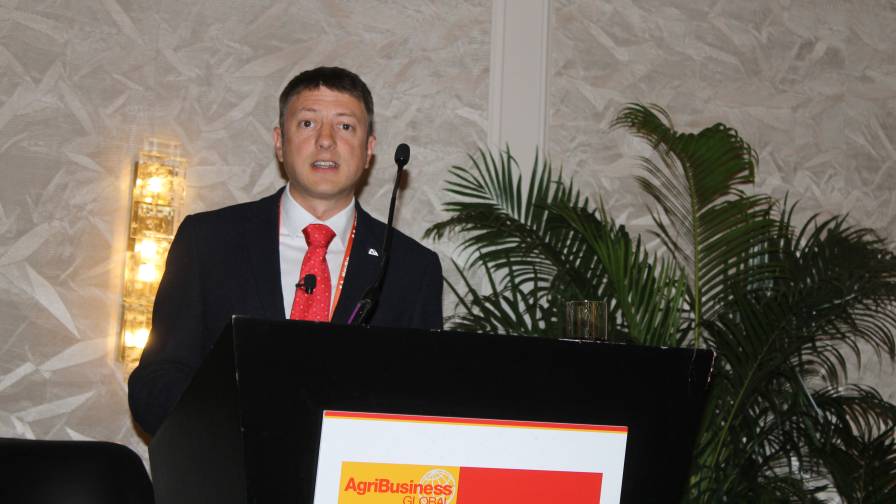The Outlook for Seed and Crop Protection: The Good, the Bad, and the Promising

Allister Phillips, AgbioInvestor Co-Founder, was one of the keynote speakers at the 2023 Trade Summit in Aventura, FL. Phillips provided the audience insight into the global seed market.
Following a four-year absence, AgriBusiness Global magazine was able to gather agrochemical representatives once again in person at the Trade Summit. Held in Aventura, FL, August 9-10, the Trade Summit brought together participants from around the globe conducting business in all sectors of the agricultural space. In all, more than 800 attendees were on hand from dozens of countries.
The event kicked off with a breakfast meeting featuring a pair of keynote speakers. Both were from AgbioInvestor, a leading source of global crop protection market information and analysis based in the United Kingdom.
First to speak to the 2023 Trade Summit audience was Allister Phillips, AgbioInvestor Co-Founder. Phillips looked at the marketplace for seed. Leading up to the COVID-19 years, seeds sales globally were in a bit of a decline, he said.
“When you look at the numbers, treated seed was worth less in 2019 than they were in 2014,” said Phillips. Fortunately, the market began to pick back up during the 2020 and 2021 growing seasons, with seed sales globally growing 2.6% during this timeframe.
And the results for 2022 show an even stronger growth curve across the entire sector. “Globally, it looks like the seed market rebounded significantly, growing 6.3%,” said Phillips. “This growth was highlighted by a 5% gain in North America and a 16.5% increase in Central and South America.”
As for particulars, in North America, seed market growth was driven by higher seed prices buoyed by higher crop prices. In part, soybeans and cotton led the way, he added.
“A greater proportion of the total soybean area was planted with higher priced Xtend and Enlist products,” said Phillips. “There also was a large increase in U.S. cotton areas following two years of decline.”
In Central and South America, soybean and cotton also spurred improved seed sales, especially in Brazil. “The sales improvement came from greater soybean area in Brazil and the launch of new technology such as Intacta 2 Xtend and Conkesta E3,” he said. “Brazil cotton also increased in area following a decline in the previous year.”
Looking ahead to 2023, Phillips said the forecast for seed sales globally looks to be another 5.9% overall increase. All regions of the world are projecting segment growth with the exception of Europe, where declines in acreage for corn and sunflower is expected to drop overall seed sales 8% this year. As in 2022, global seed sales are anticipated to be strongest in North America and Central and South America, increasing 8.5% and 13%, respectively.
“In North America, high energy prices and relatively high commodity prices have continued the rise in average seed prices,” said Phillips. “And there’s a greater market share for Enlist 3 soybeans.” He added that Enlist supplier Corteva estimates these soybeans now account for 55% of the entire soybean seed marketplace.
A Crop Protection Market Disconnect

AgbioInvestor Co-founder Derek Oliphant also presented during the keynote address at the 2023 Trade Summit. He spoke with visitors about the outlook for global crop protection.
Following Phillips, AgbioInvestor’s other Co-Founder, Derek Oliphant, spoke with 2023 Trade Summit visitors about the outlook for global crop protection. Although much has been made about agrichemical companies experiencing sales downturns, Oliphant said market observers need to consider on-the-ground crop protection product usage rather than relying solely on larger trends.
“Inventories were built up due to high levels of pre-purchasing to alleviate supply concerns and unfavorable mid- to late-season weather on key regions, such as the Western U.S. and Europe,” he said. “Retailer and on-farm stocks are now being used, with usage on the ground sustained due to relatively high pest pressure and improved conditions in regional markets. Company sales are also being impacted by an overall reduction in agrichemical pricing.”
When all is said and done, Oliphant told Trade Summit attendees the prediction for crop protection market sales for 2023 is $76.8 billion, an improvement of 2.8% compared with 2022 growing season. Market growth will be led by Europe at 6.1% and Central and South America at 6.3%.
Looking even further ahead, Oliphant envisions the global crop protection marketplace remaining relatively vibrant until close to the end of the 2020s. “By 2027, there are several positive and negatives factors that will shape this industry,” he said. “Among positive drivers will be pest resistance development aid value, developing markets such as Southeast Asia and Middle East/Africa, and the further uptake on seed treatments and biologicals. Among the negative drivers will be new genetically-modified areas and traits detracting from market value and volume, the accelerating impacts of variable-rate applicators, and commodity/input prices normalizing.”






